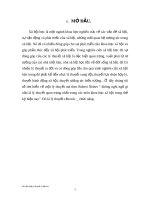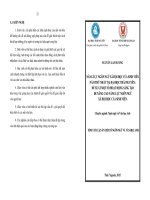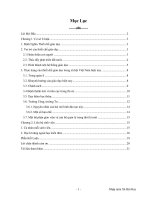TIỂU LUẬN NGÔN NGỮ XÃ HỘI HỌC
Bạn đang xem bản rút gọn của tài liệu. Xem và tải ngay bản đầy đủ của tài liệu tại đây (96.72 KB, 8 trang )
Student Name: CAO TUẤN MẠNH
Student code:7052900511
Class: Nghe An 6
Observe how young children address each other and try to describe
their ‘rules of politeness.’ Contrast these rules with those of their parents.
How do you learn to be polite?
1. Rules of politeness
Politeness is an important aspect of language because it can help people
communicate more quickly. Children learn politeness through their social
environment from an early age. Children are taught how to greet people politely,
express their desires in an ethical manner, express curiosity, and express
disagreement without screaming or using high voices, among other things. This
study involved phenomenological qualitative research, which examined the natural
phenomena of language. Data were collected by listening to the use of language
without participating in the discussion process and using other free listening
techniques. The purpose of the note technique that was used was to observe
linguistic phenomena as they occurred. According to the findings, children's
language politeness in the family environment was heavily influenced by the
situation and circumstances of the environment. Children who had grown up in a
market environment had different communication language.. Children used
greetings, permission, thanks, and prohibitions as examples of imperative speech
as a sign of politeness. Furthermore, the politeness of language in the children from
the market environment had an effect on the intonation of the child's voice when
speaking, as well as the child's kinesthetic signals.
Modesty is a very important aspect of language, because politeness can
facilitate interaction between individuals. Language politeness was introduced by
children from childhood through their social environment. The role of adults,
especially parents and caregivers, is very much needed in this process. When they
enter the preschool period, children solidify their knowledge of politeness through
teachers and friends. Children begin to be introduced to how to greet people
politely, express their desire ethically, express curiosity, express disagreement
without high voices and voices, and so on.
As part of a community group, children also learn how to behave when they
are involved in conversation. There are some rules that they need to know when
interacting with others; one of them is politeness. In courtesy, children learn that
there are some rules that govern speech when they engage in conversations with
others.
Therefore, it is not surprising that at this time it is increasingly realized how
important the role of teachers in institutions is as educators who interact directly
with children as students in shaping personality, attitudes, mental, intellectual,
especially values of politeness in language.
Dimensions of Childliness
There are several forms of greetings including me, us, you, father, mother or
you. This form of greeting implies distance. Therefore, this form of greeting is
usually used as a form of negative politeness. Meanwhile, in some places there are
also greetings like me, us (you), uncle or aunt. These forms imply closeness or
familiarity, and are usually used as a form of positive politeness.
The name kinship is also often used to indirectly show respect and distance.
The teacher calls the student's grandmother as grandparents or opung, for example,
to show their respect for the grandmother, as well as to appreciate their regional
origins. In this case, the teacher uses negative politeness. In certain schools,
positive politeness is indicated by a call to the parents of their mother's special
child. In some schools, the teacher calls the mother of the child as the mother or
mother. By calling mom or mother, the teacher intends to align himself with the
child, and familiarize himself with his mother. This is done so that the teacher
expects a positive response from the child. A different reaction will certainly occur
if the teacher calls the mother Mother. Even though it is considered polite, this
term implies the distance between the teacher and the mother and indirectly
between the teacher and the child.
An interesting development is the use of my word at preschool age. At this
very young age, they used my word after they understood the use of their names.
The use of this word is very productive. Along with my words, children also
understand who is called you and him. At this age, it seems they have not realized
that there are social rules that limit the use of those words. Children freely use
these words to talk to adults and talk about adults. What sentence are you like? will
be considered a neutral sentence if spoken by an adult to a child; and will be
considered a sentence that is not polite if spoken by the child to the parent. In this
case, the child must learn when to use your word for the second person, or use
another word.
Since childhood, especially in big cities whose population comes from
various ethnic groups and languages, are faced with various rules of behavior and
language. They are taught ways to express gratitude when given something,
apologize when doing something that is considered detrimental to others and ask
permission when going to do something. The school environment consisting of
teachers and classmates indirectly exerts a considerable influence on manners. The
teacher introduces a number of social language rules, such as how to greet,
introduce yourself, express respect and gratitude, apologize, ask permission, and
ask for help.
Childliness in the Imperative Sentence
Politeness in speaking needs to be accustomed early in the family
environment and education. According to Rahardi, politeness research examines
the use of language (language use) in a particular language society. The speech
community in question is a society with a variety of backgrounds in the social and
cultural situations that embody it.
Wijana and Rohmadi revealed that as interpersonal rhetoric, pragmatics
require the principle of politeness (politeness principles). The principle of modesty
is related to two conversation participants, namely themselves (self) and others
(other). Self is a speaker, another person is the opposite of speech and the third
person is spoken by speakers and opponents of speech. Courtesy especially in the
sentence of order or request has its own grounds for consideration. Keraf [3]
explains that the command sentence is a sentence which contains orders or requests
that other people do something, as desired by the person who ordered. Someone
who uses imperative sentences must use clear sentences so that what is desired can
be understood and carried out by opponents.
The command sentence according to Keraf [4] can range from a very rude
order to a very subtle request. Furthermore, this expert states that the command
sentence contains the following characteristics:
(1) using loud voice intonation, especially ordinary commands and
prohibitions,
(2) hard verbs, especially, ordinary commands and prohibitions,
(3) verb which supports the contents of the command, usually the basic
word, and
(4) uses hardened particle.
The command sentence in Indonesian has various types. Keraf in Rahardi [5]
revealed that the command sentence can be divided into nine types, namely:
(1) ordinary commands, (2) requests, (3) permissive commands, (4)
invitations, (5) conditional orders, (6) satire orders, (7) prohibition orders, (8)
orders of hope, invitation, (9) exciting. Rahardi concluded that the linguistic
modesty of the Indonesian imperative speech includes the following: (1) short
length of speech, (2) speech sequence, (3) speech intonation and kinesthetic
signals, (4) markers of politeness markers. There are at least ten kinds of markers
that can determine the linguistic politeness of imperative speech in Indonesian.
Significance of the linguistic politeness of the imperative speech is please, please,
please, let, come on, try, hope, wish, (it / it), and be willing to. The use of these
markers in imperative speech will create politeness.
2. How to learn to be polite
The politeness of speaking children
The use of phrases that mark the politeness in the use imperative speech is
largely determined by the appearance or appearance of politeness markers. From a
variety of markers of courtesy of children can be mentioned as follows: please,
please, please, come on, let me, try, hope, thank you.
The expression marker politeness allows
Teacher, please help us to the bathroom, I want to pee (urinate)
Speech information: This statement is delivered by the child to the teacher
who wants to get permission to the room small to urinate. Taboo speeches are
sometimes also used by children to the teacher. Sexual utterances, utterances that
refer to body organs commonly covered with clothing, words that refer to
something disgusting, and "dirty" and "rude" words including taboo words used in
speaking in class.
The following example is a speech that uses taboo speech because it is
spoken by students to the teacher when learning is taking place.
Teacher, I want permission to leave for a while, I want to defecate!
Speech information: This statement is delivered by the child to the teacher
who wants to go to the restroom to defecate
Examples of student sentences that are classified as taboo above will be a polite
expression if changed with the use of euphemisms, for example as follows:
(1) Teacher, I want to ask permission for a while, I want to defecate. Or,
even more subtle:
(2) Teacher, I want to ask permission for a while, I want to go to the
restroom. Or, the most subtle:
(3) Teacher, I ask permission for a while, I want to go back.
And the teacher can answer politely, please kid! Or it could be a bit of a
message due to the condition of children who always play, like this:
Please kid, when it's done, go back to the room right away!
Expression of politeness greetings Child language politeness can be seen
from the child's speech acts in daily interactions.
Said polite greetings taught to children, including teaching children to say
hello. Familiarizing children to say hello is one of the politeness of speaking
children. When children say hello, children are trained to appreciate the existence
of people around them and can establish intimacy with each other. Said polite
words that were used when entering the classroom, for example, when the teacher
greeted him when he entered class.
- Teacher: Good morning children.
- Student: Good morning, teacher.
Another example is when a child will say goodbye to parents who deliver to
the school yard:
- Child: Sir, I'm in this class!
- Old man: Yes, kid
(the child while crouching kissing his father's hand as a sign of respect for
the child to the parents and the form of polite behavior between children and
parents)
Familiarizing children with greeting people and saying goodbye when going out or
going to separate ways is one of the ways parents educate children in behaving and
polite in language. When children say goodbye, parents feel children are still under
the control of parents. By saying goodbye, parents can check the whereabouts of
their children and be able to monitor the activities they do or with whom they are
close friends.
The expression of politeness markers of thanks
Thank you is a simple word, but it has a huge meaning. If the utterance is
spoken with a sincere heart, the difference will appear clearly. When children grow
up to adolescence and become adults, this thank you does not necessarily come out
just like that but must be accustomed from an early age.
By saying thank you, without us realizing we have instilled an attitude to be
able to respect others while accustoming children to being able to give thanks for
everything they receive. Both parents and teachers must always be good examples
for children. When they are accustomed to hearing thank you words from people
around him, then he will build his awareness to do the same thing when interacting
with anyone.
Children are getting used to saying thank you when getting something or
getting something. Something that can mean, when they get gifts, candy, food, or
valuables. Example of the speech:
- Child: Teacher, what is dih?
- Teacher: This is a chocolate gift, son, because Nabila had answered the
teacher's question correctly.
- Child: oo, thank you very much, teacher
- Teacher: You're both kids
Based on the speech politeness of the children above, children need to get an
understanding that saying the word "thank you" should not only be when we get
something that is visible, but also when we receive the kindness and help of others.
It also includes the merits that we deserve as a result of paying for their services,
such as the goodness of motorbike taxi drivers who take them to their destination,
or the gaps that help clean up at home, or cleaning services at school or others.
Examples of other utterances:
- Cleaning service: excuse the children, mother clean the remnants of
paper cutouts first, then after that the game will continue again...!
- Son: Thank you mom...
- Cleaning service: both dear
With the thanks conveyed by the children, they were indirectly invited to
feel how happy and happy someone's feelings were to hear these words because
their actions were valued.
Child kinesthetic signals
Opponents of children's speech are teachers and other adults who are in
school every day, such as school staff, cleaning service and canteen keepers.
Therefore, the interlocutor of the child in speaking should speak polite and subtle
language in order to consider the child's psychology. Whereas kinesthetic signals
that follow speech are usually limited to facial expressions. For example, there are
children who do not like or like something, he will show a sullen facial expression,
turn or run away without words.
In another example, a student was told by one of the teachers to work on the
problem in front of the class because they did not master, the child answered:
"No, it can't be bu, the problem is hard" (verbal)
(while shaking his head and waving (kinestik)).
The child should be able to reject the teacher's request in a polite manner, by
answering: "Sorry my mother did not understand how to work on the problem"
(verbal). The teacher hears the child's answer, too, must be wise, perhaps by
persuading and motivating the child with utterances that make the child confident
and dare to try even though he is not sure the answer is correct. The teacher should
speak, "Andi, please try first son, you believe Andi can help you later." The
teacher's speech made the child's heart melt and wanted to try working on the
questions on the board. However, what needs to be considered in this context is
kinetic or gesture. Gestur can be used to create language politeness, and can also
be misused to create language impolence.
Based on the data obtained, there is one child who shows a smiley facial
expression and feels happy when the child enters the class and this will create
politeness, but on the contrary there are children who show gloomy facial
expressions when entering class and things this is considered less polite. Another
thing that needs to be attempted is to maintain the atmosphere or situation of
communication between the teacher and students. For example, when teaching new
things that require serious joint discussion with children, it is not polite when
children run in class or go out in class especially when they are loud. The tendency
to dominate the conversation, when discussing in class, of course the attitude is not
polite, chatting with the next friend when the teacher is explaining the lesson,
looking in another direction with harassing the speaker, namely the teacher who is
just delivering material in class, chuckling or cynical is part ways that do not
maintain a conducive, peaceful, and pleasant communication atmosphere, which
can result in disrupting communication objectives. So, value and politeness have
very close ties. Someone is considered not polite and does not practice good values
when talking using harsh speech. C. Closing Language politeness in children can
be seen from the family environment and the learning process in the school
environment. From the results of this study it was found that the language
politeness of children in the family environment is very much determined by the
circumstances and circumstances.
This is found in children who come from the market environment have
different languages in communication. Students are taught how language is
actually in the sense of using language to interact communicating with other
people or others.
Through the research on the courtesy of children, it was concluded that
students used imperative speech as a sign of politeness through speech such as
greetings, permission, thanks, and prohibitions. Furthermore, the language
politeness of children originating from the market environment has an effect on the
politeness of the language in this case the child's voice tone when speaking, as well
as through the child's kinesthetic signals.
3. Conclusions
Language politeness in children can be seen from the family environment
and the learning process in the school environment. From the results of this study
found the politeness of children's language in the family environment is very
determined situation and environmental conditions. This is found in children who
come from the market environment have different languages in communication.
Students are taught how real language in the sense of using language to interact
communicating with others or each other, through imperative speech as a sign of
politeness through speech such as greetings, asking for permission, thank you, and
prohibition. so is the tone of the child's voice when talking through kinesthetic
cues.









